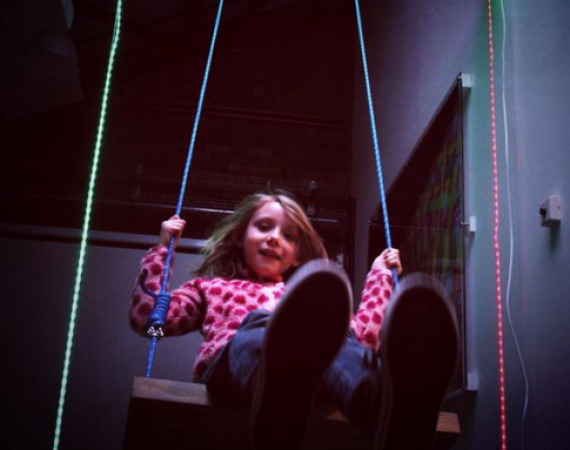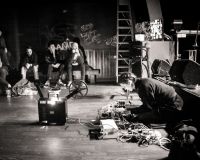Studio blog
Posted on Fri 20 Feb 2015
Talking treasure troves and texting trees in texas...
This week, we are hugely excited to find out that Jonathan Chomko and Matthew Rosier’s 2014 Playable City Award winning project, Shadowing has been nominated for the Design Museum’s Designs of the Year award...

Connected Play set up a swing in the Studio as part of the last REACT Play Sandbox workshop. Photo @ReactHub
Posted by

Jasmine Butt
Jasmine is a musician, synth builder and AV artist who is currently exploring modular synthesis.This week, we were hugely excited to find out that Jonathan Chomko and Matthew Rosier’s 2014 Playable City Award winning project, Shadowing has been nominated for the Design Museum’s Designs of the Year award. 2013’s Playable City Award project, Hello Lamp Post is still live in Austin as part of SXSW 2015, and has been getting a lot of attention. Read what the people of Austin are sharing with street furniture here. These two brilliant projects are soon to be joined by another. The 2015 Playable City Award will open to applications next week! Follow @PlayableCity for updates.
On Monday, we swung from the Studio beams, strategically stacked fabulous beasts and had a lot of valuable conversations with researchers, designers and children about the best kinds of play. This was the last REACT Play Sandbox workshop before their work in progress show next week, and it was wonderful to see how the six projects have taken shape over the course of their 4-month sprint:
The Fabulous Beasts team (originally called Strax) have been developing a physical/virtual stacking game. Fabulous Beasts is a world-making game that combines the tactility of a board game with the sophisticated scoring of a computer. The Young Coaches had a brilliant time playtesting, getting their heads around the rules faster than any of us…
The Teleportation Tent team are creating a pop-up tent, which will come alive with 360 degree projection, throwing an interactive narrative on the walls. When children enter the tent, they will be able to teleport to different worlds and meet different characters. Amy, May, Lee and Tom set up camp one of the Watershed conference rooms to explore ways in which children could make creative contributions to the landscape and characters in the story.
The Trove team are creating a box for storing precious objects and stories, to support children through times of uncertainty and change. Trove will enable children to attach audio recordings to their most precious keepsakes. Chloe wants the box’s interface to be as intuitive as possible, so that children can learn to use it themselves, and have complete ownership of the box and their things. There will be no written instructions or screens, only a voice explaining how Trove can be used.
The Mattie Moreorless team have been working on an iPad game to help children with Down’s Syndrome to develop their sense of magnitude and understanding of numbers. You play as a character who journeys through different planets, encountering different obstacles along the way. You have to choose to either reduce or increase the size of objects in order to progress in the game.
The Connected Play team have been exploring ‘the playground of the future’. They are specifically developing a digitally enhanced set of swings, where light and sound will turn the familiar act of swinging into games for both individual play and play in groups. They suspended a swing from the Studio beams, and bordered it with controllable strips of RGB LED lights. As the Young Coaches swung, Tine and Seth changed the colours of the lights to test out different kinds of game mechanisms.
The Mighty Minis team have been creating physical toys that are each connected to their own dynamic, online character. They have created little egg-shaped toys containing sensors that detect motion. The more they are played with, the more the virtual character evolves. The emphasis of the project is to get children away from the screen and engaging in physical play in the real world. Esther and Silas have briefed the young coaches to present their project for them at next week’s showcase.
Play will be the last Sandbox Scheme of the 4-year REACT project. After the sandbox comes to a close, REACT will focus supporting and celebrating its alumni. REACT are looking for a new researcher to help them explore the network of academics and creative companies over the course of the last 3 years, investigating the value that these networks produce in the creative economy. Find out more about the opportunity here.
This week, Di Mainstone has been developing her Human Harp project, which will see Clifton Suspension Bridge transform into a mammoth musical instrument. She has been getting up at the crack of dawn and heading to the Suspension Bridge to test the resonant sounds of the bridge’s cables with their new UE Boom speaker. She found that the sound really travels - they made this vine of the test.They have also uploaded the ‘Clifton Scale’, to Soundcloud. This is a recording of the sound of each cable being struck which ascends in pitch as the cables get shorter. They have been chatting with Steinway Pianos about how the position of their ‘mechanical dongers’ might imitate a piano.